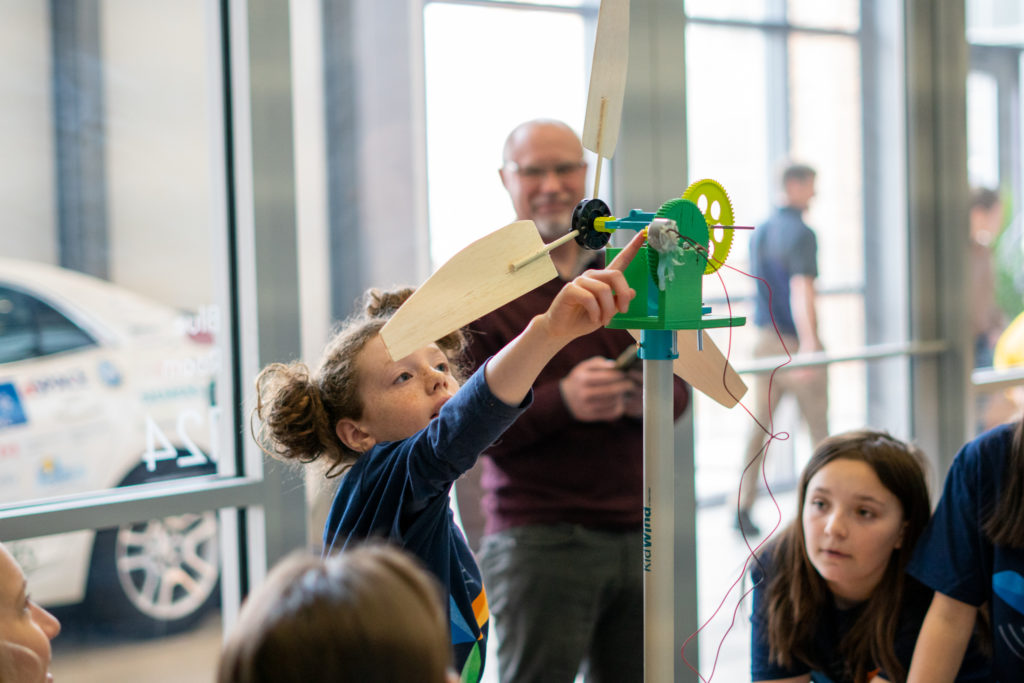
A cool, continuous draft circulated at Colorado State University’s Powerhouse Energy Campus last Wednesday. The source wasn’t a propped door but rather the Energy Institute’s 4th annual KidWind Challenge, featuring model wind turbines and excited gasps.
Teams ranged in age from elementary to high school coming from as far away as Frisco, Colo., for one of two regional events in the state. The STEM program, which started in 2003, is a hands-on design celebration that engages students through the lens of wind and solar energy. Student teams design, construct and test small scale wind turbines and solar structures at events all over the world.
From 9 a.m. to 2 p.m., students competed to see which team had the most powerful windmill in addition to mini challenges, a Powerhouse tour, free lunch, and a commemorative t-shirt. Awards were made in-house from the Rapid Prototyping Lab in the shape of gears.
Orchestrating the day was Priscila Lopez Mendez, a fourth-year mechanical engineering student at Colorado State University, who started planning last July after becoming a KidWind Coordinator.
“Last year, I was a volunteer and when I learned about the opportunity to be the coordinator, I quickly jumped at it,” Mendez said. “I really enjoyed seeing the event come to life, it was a very rewarding part of the process. Being able to see students from K-12 be interested in STEM is really inspiring. I hope to continue to do outreach events, teaching the youth about engineering and renewable energy as it is a field that I am passionate about and I look forward to work in upon graduation.”
How Does it Work?
KidWind, through their partners at Vernier, have a number of kits and materials to put projects in motion. Teams can get creative as long as they stay within the rule book. The turbine consists of a generator, blades, gearboxes, and a tower. Blades were made from custom crafted wood, chop sticks with tarp material or 3D printed assemblies, although teams also considered size, weight and quantity of their parts.
The Energy Institute provided the wind tunnel – a stacked square setup of four 24-inch fans – and a multimeter, which reads the volts, amps and joules. Teams arrived with concepts and completed windmills but had opportunities to test and tweak their structures to score their best energy output. In addition to the numbers, teams were accessed for independence, innovation, presentation, complexity and more.
While the windmill represented 85% of each team’s score, the remaining 15% went to mini challenges – the Sail Car Distance and the MacGyver Lift Weight. The first tasked participants in manipulating the size of the sail, axle, weight and more to travel the furthest distance. The winning car from Burlington Elementary School Team 2 rolled 44 feet. The Macgyver Lift Weight consisted of making a fan that as it spun, it had to be able to pick up weight and, in this case, washers. The Wheat Ridge High School team outmuscled the competition with 51 washers.
Judges & Results
Five teams competed against each other in the elementary and middle school division, while one high school team tested their project. Winning second place in the elementary/middle school bracket was Abby Heider, a team of one from Merill Middle School, who said she will share her experience with classmates with hopes to gain a teammate or two for next year. Taking first place was one of the three teams from Burling Elementary School in Longmont, Colo.
Elementary/Middle School:
1st – Burlington Elementary School Team 2 (91.20 points)
2nd – Abby Heider (82. 58 points)
3rd – Mitchell Elementary (77.84 pts)
4th – Burlington Elementary School Team 1 (76.78 pts)
5th – Burlington Elementary School Team 3 (63.97 pts)
High School:
1st – Wheat Ridge High School (82.26 pts)
Helping score the event were a few representatives from The AES Corporation, a Fortune 500 global energy company accelerating the future of energy.
“KidWind is just so much FUN,” the Energy Institute’s operating director Jason Quinn said. “I look forward to this event every year as it brings in a group of middle and high school students who are excited about renewable energy. The event sparks some of the best conversations including a rumor about a dragon that lives in the basement of the Powerhouse. How else do you explain the noises and huge back door?”
The Energy Institute hosted one of two regional events across Colorado with the 2023 National KidWind Challenge scheduled for May 14-17 in Boulder, Colo.
@csuenergyinstitute Energy Institute’s 4th Annual KidWindChallenge was a blast ? #kidwind #windenergy #outreach #STEM #windmill ♬ Reflections on 52nd – Psyched on Sound